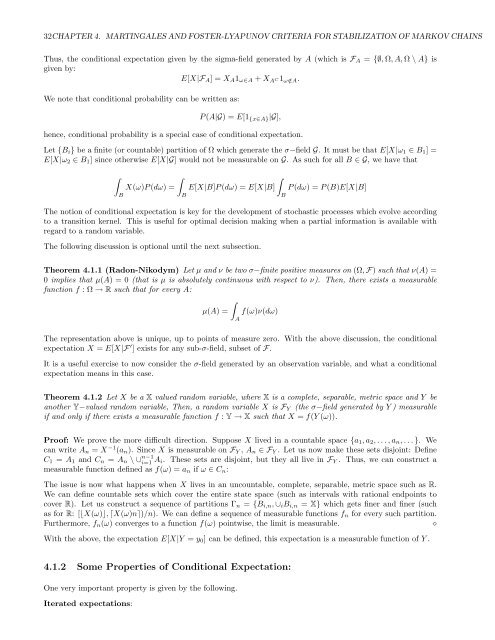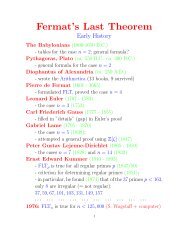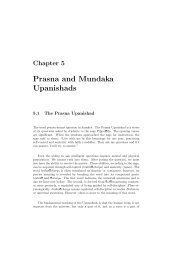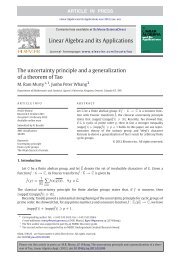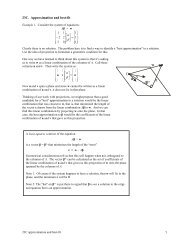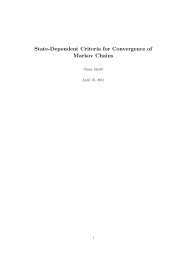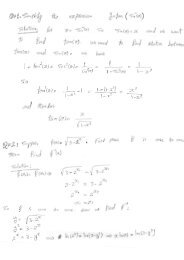Lecture Notes - Department of Mathematics and Statistics - Queen's ...
Lecture Notes - Department of Mathematics and Statistics - Queen's ...
Lecture Notes - Department of Mathematics and Statistics - Queen's ...
You also want an ePaper? Increase the reach of your titles
YUMPU automatically turns print PDFs into web optimized ePapers that Google loves.
32CHAPTER 4. MARTINGALES AND FOSTER-LYAPUNOV CRITERIA FOR STABILIZATION OF MARKOV CHAINS<br />
Thus, the conditional expectation given by the sigma-field generated by A (which is F A = {∅, Ω, A, Ω \ A} is<br />
given by:<br />
E[X|F A ] = X A 1 ω∈A + X A C1 ω/∈A .<br />
We note that conditional probability can be written as:<br />
P(A|G) = E[1 {x∈A} |G],<br />
hence, conditional probability is a special case <strong>of</strong> conditional expectation.<br />
Let {B i } be a finite (or countable) partition <strong>of</strong> Ω which generate the σ−field G. It must be that E[X|ω 1 ∈ B 1 ] =<br />
E[X|ω 2 ∈ B 1 ] since otherwise E[X|G] would not be measurable on G. As such for all B ∈ G, we have that<br />
∫<br />
B<br />
∫<br />
X(ω)P(dω) =<br />
B<br />
∫<br />
E[X|B]P(dω) = E[X|B] P(dω) = P(B)E[X|B]<br />
B<br />
The notion <strong>of</strong> conditional expectation is key for the development <strong>of</strong> stochastic processes which evolve according<br />
to a transition kernel. This is useful for optimal decision making when a partial information is available with<br />
regard to a r<strong>and</strong>om variable.<br />
The following discussion is optional until the next subsection.<br />
Theorem 4.1.1 (Radon-Nikodym) Let µ <strong>and</strong> ν be two σ−finite positive measures on (Ω, F) such that ν(A) =<br />
0 implies that µ(A) = 0 (that is µ is absolutely continuous with respect to ν). Then, there exists a measurable<br />
function f : Ω → R such that for every A:<br />
∫<br />
µ(A) = f(ω)ν(dω)<br />
A<br />
The representation above is unique, up to points <strong>of</strong> measure zero. With the above discussion, the conditional<br />
expectation X = E[X|F ′ ] exists for any sub-σ-field, subset <strong>of</strong> F.<br />
It is a useful exercise to now consider the σ-field generated by an observation variable, <strong>and</strong> what a conditional<br />
expectation means in this case.<br />
Theorem 4.1.2 Let X be a X valued r<strong>and</strong>om variable, where X is a complete, separable, metric space <strong>and</strong> Y be<br />
another Y−valued r<strong>and</strong>om variable, Then, a r<strong>and</strong>om variable X is F Y (the σ−field generated by Y ) measurable<br />
if <strong>and</strong> only if there exists a measurable function f : Y → X such that X = f(Y (ω)).<br />
Pro<strong>of</strong>: We prove the more difficult direction. Suppose X lived in a countable space {a 1 , a 2 , . . . , a n , . . . }. We<br />
can write A n = X −1 (a n ). Since X is measurable on F Y , A n ∈ F Y . Let us now make these sets disjoint: Define<br />
C 1 = A 1 <strong>and</strong> C n = A n \ ∪ n−1<br />
i=1 A i. These sets are disjoint, but they all live in F Y . Thus, we can construct a<br />
measurable function defined as f(ω) = a n if ω ∈ C n :<br />
The issue is now what happens when X lives in an uncountable, complete, separable, metric space such as R.<br />
We can define countable sets which cover the entire state space (such as intervals with rational endpoints to<br />
cover R). Let us construct a sequence <strong>of</strong> partitions Γ n = {B i,n , ∪ i B i,n = X} which gets finer <strong>and</strong> finer (such<br />
as for R: [⌊X(ω)⌋, ⌈X(ω)n⌉)/n). We can define a sequence <strong>of</strong> measurable functions f n for every such partition.<br />
Furthermore, f n (ω) converges to a function f(ω) pointwise, the limit is measurable.<br />
⋄<br />
With the above, the expectation E[X|Y = y 0 ] can be defined, this expectation is a measurable function <strong>of</strong> Y .<br />
4.1.2 Some Properties <strong>of</strong> Conditional Expectation:<br />
One very important property is given by the following.<br />
Iterated expectations:


